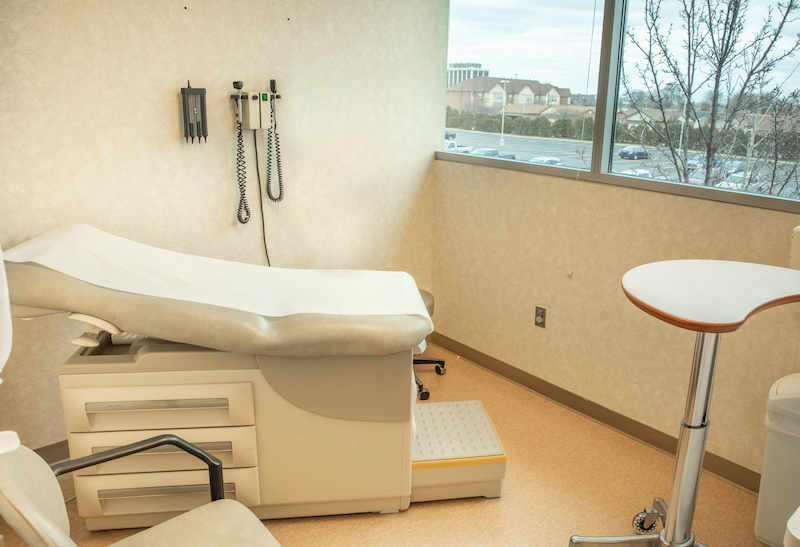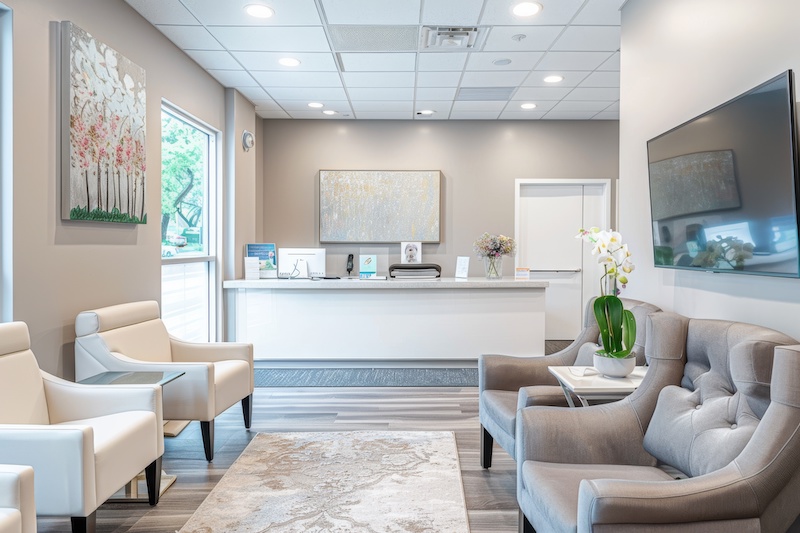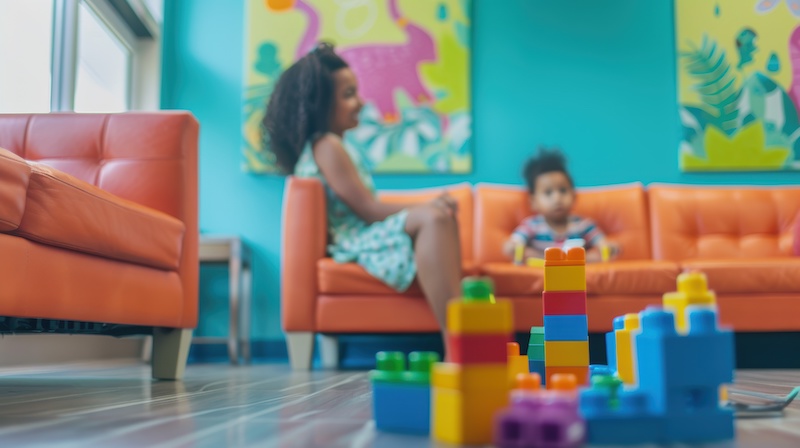A medical office is more than just a place with medical stuff. It’s where patients come when they’re worried, in pain, or need help. How the space looks and feels matters a lot.
Good design can reduce anxiety, help staff work better, and make the whole place feel both professional and friendly. Color psychology, seating choices, lighting, and more all need to be thoughtfully incorporated. Let’s look at simple ways to create a doctor’s office where patients feel better just by walking in.
Save This For Later! Quick Tips For a Better Medical Office:
- Add more natural light when possible
- Choose calming wall colors like soft blues and greens
- Add wall art that helps patients relax
- Pick comfortable chairs instead of shared seating
- Include plants to bring nature inside
- Tailor your design choices to your clientele
Let the Light In: Brighten Your Office Space

Dark, dim medical offices feel depressing. Nobody wants that.
Natural light changes everything. It lifts moods and makes spaces feel alive. More windows mean less anxiety for patients and more energy for your staff.
Big windows give your medical office a fresh, modern look. They bring warmth and brightness that makes people feel better right away. Want privacy too? Try sheer curtains. They let light in while keeping prying eyes out.
No windows in exam rooms? No problem. Try LED lights or cove lighting that looks like natural daylight. These small changes make a huge difference in how your space feels.
Bright spaces help healing. Patients feel it right away. They’re calmer, less stressed, and more comfortable during their visit.
Skip the Sterile Look: Choose Warm Colors for Your Walls
Think about the last time you were in a medical office with bright white walls. How did it make you feel? Probably not great.
White walls scream “clinical” and can actually make patients more anxious. Instead, choose colors that welcome people in while still looking professional.
The best approach? Start with a warm neutral color base (think soft grey or beige) and add gentle accent colors like muted blues or greens. Scandi color schemes are a great place to look for inspiration.
Colors That Work Best in Doctor’s Offices

Soft Blues and Greens: These colors actually lower stress levels. They create calm in waiting areas and exam rooms where patients need it most.
Earthy Neutrals: Beige, taupe, and warm grey add comfort without being too much. They look clean but not cold.
Gentle Pastels: Light sage green, lavender, or blush pink can add subtle color. These work great in pediatric offices or wellness clinics.
Wood Tones: Adding wood in furniture, trim, or accent walls brings natural warmth that fights that sterile feeling.
Colors to Skip
All White Everything: White says “clean” but too much feels cold and intimidating. Mix it with softer colors instead.
Bright Reds and Yellows: Red can make heart rates jump. Bright yellow feels too stimulating. Use these only as tiny accents, if at all.
Super Dark Colors: Deep colors like black or navy can make spaces feel smaller and less welcoming. If you love them, use them only for small accents.
Doctor’s Office Wall Art: Choose Pieces That Calm and Welcome
Choosing the right wall art does more than fill empty walls. It can calm anxious patients and show what your practice is all about.
For waiting areas, choose soothing scenes. Nature photographs like forests, flowers, or ocean views give anxious patients something calming to focus on. Look for high-quality prints in soft colors that make the space feel warm. Alternatively, consider vibrant, engaging pieces to help occupy patients while they wait.
For exam rooms, try abstract art. Decorating with gentle abstracts in blues and greens offer a sense of calm without demanding too much attention. They work great in treatment rooms where patients need to relax.
Local art creates connection. Displaying work from artists in your area makes your office feel more familiar and less corporate. Art of local landmarks gives patients something easy to help start a conversation.
Running a pediatric office? Try fun, medical-themed wall art or interactive walls. These keep kids engaged and less scared about their visit.
You can show off your credentials, too. Just do it tastefully.
The right wall art transforms your space from “just another doctor’s office” to a place where patients feel truly cared for.
Seating Matters: Give Patients Their Space

The waiting room is where patients spend most of their time. How they sit affects how they feel.
Skip the shared couches. Most people hate sitting next to strangers, especially when they’re not feeling well. Individual chairs with armrests give each person their own space. Place them far enough apart so patients don’t feel cramped.
Comfort counts too. Choose padded, fabric-covered chairs over hard plastic or metal ones. Your patients’ backs will thank you, especially during long waits.
Good seating might seem like a small detail, but it makes a big difference in how patients feel about their visit.
Bring in Plants and Natural Touches
Adding some green to your medical office is one of the easiest ways to make it feel more alive and welcoming.
Put plants in waiting areas, exam rooms, and at the reception desk. They add warmth and a touch of freshness. Don’t worry about maintenance—snake plants, pothos, and peace lilies are nearly impossible to kill and thrive indoors.
Not into plant care? Try nature-inspired art instead. Landscape paintings, botanical prints, or nature photographs create the same calming effect as live plants. Research shows that even looking at nature images can lower stress and anxiety.
For an extra calming touch, consider adding a small fish tank to your reception area. Watching fish swim is surprisingly soothing and gives children and nervous patients something to focus on.
Design Options That Work for Different Medical Spaces

The design needs of a medical office can vary based on what type of practice you run. Here are some options to consider:
Primary Care Offices: These spaces should feel welcoming and comfortable. Choose warm wall colors and familiar artwork that helps patients feel at ease during routine visits.
Pediatric Spaces: Kids respond well to bright, engaging colors and interactive design elements. Wall art with animals or whimsical scenes can turn a scary doctor visit into something more fun.
Specialty Practices: For spaces where patients might feel extra anxious (like dental offices), focus on creating maximum comfort. Consider TVs on the walls or ceiling, noise-canceling features, and extra cozy seating.
Minimalist decor keeps things visually clean (and easy to physically clean), which makes it a great option in medical settings. However, it’s important to balance clean style with comfort. A bit of visual clutter in a pediatric waiting room is worth it if it helps a kid’s visit go more smoothly.
The best design options balance what looks good with what helps patients feel better. Choose products that serve both purposes whenever possible.
Creating a Space That Works for Everyone
A well-designed medical office balances looking good with working well. The right colors, comfortable furniture, good lighting, and thoughtful wall art all work together to create trust and calm. Snag some home and corporate office design ideas for extra functionality.
Whether you’re planning new construction or updating an old space, these simple changes can transform your medical office. Patients will notice the difference right away—and so will your staff.
Make your doctor’s office a place where healing begins the moment someone walks through the door. The right design choices today can create a more positive experience for everyone who enters your space.




